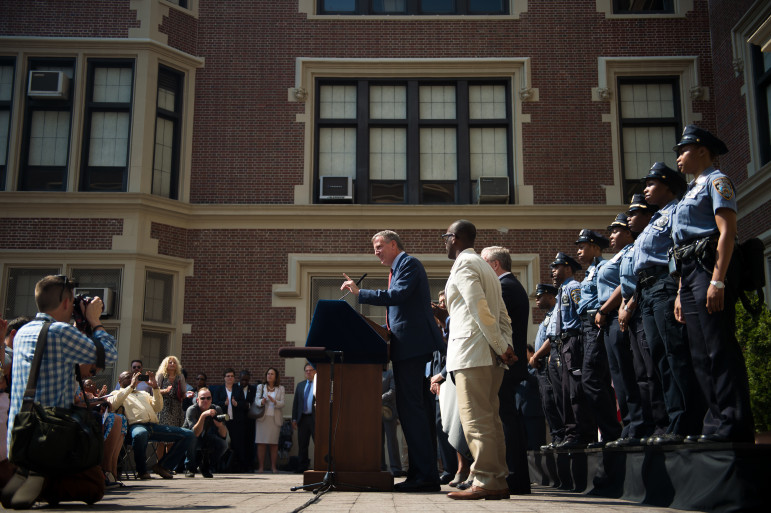‘Mayor Bill de Blasio’s executive budget proposal for the coming fiscal year, which includes plans to increase funding for school police, tells us that our city’s leaders care more about controlling and arresting students than making sure they feel safe, supported, and cared for in schools.’

Ed Reed/Mayoral Photography Office
Mayor de Blasio at an annouement with School Safety agents in 2014.Schools should be nurturing environments that promote student health and well-being. Policing is antithetical to this goal. Yet, Mayor Bill de Blasio’s executive budget proposal for the coming fiscal year, which includes plans to increase funding for school police, tells us that our city’s leaders care more about controlling and arresting students than making sure they feel safe, supported, and cared for in schools.
School policing is a public health crisis, inflicting disproportionate harm on the city’s students of color. The very students most impacted by school police are also those at the highest risk of experiencing health-harming conditions, such as adverse childhood experiences. School policing compounds the risk of these health-harming conditions, further amplifying racial health disparities and jeopardizing the long-term well-being of the most vulnerable students.
Even just one court appearance can triple the chances of a student not finishing high school. Educational attainment is a strong predictor of a host of health outcomes, including chronic illness and life expectancy, and when youth are pushed out of school, they are deprived of the many health benefits tied to education.
Research shows that students stopped by school police experience higher rates of mental health problems, such as posttraumatic stress and emotional distress. And police presence weakens students’ sense of connection to school, a critical factor for protecting against unhealthy behaviors and outcomes, like substance use and suicidal ideation or behaviors. Police additionally threaten students’ physical safety—reports abound of school police inflicting serious injuries, including through gender-based abuse.
Despite knowing this, New York City schools continue to usher students into the juvenile legal system. At a time when city public school buildings are at less than 30 percent capacity, the New York Police Department (NYPD) continues to carry a strong presence, intervening 220 times in schools from January – March 2021, according to NYPD data.
Children as young as 5 years old have experienced police interventions in schools. What purpose is served by maintaining, or even increasing that presence? For $450 million this year, school policing is on track to have targeted 300 students in their schools. That’s $1.5 million per student, with each police interaction hurting students mental, emotional, and sometimes physical health.
Over the past year, we’ve seen a groundswell of action by government leaders, the public and private sectors, and academics to address the effects of individual and structural racism on health. Locally, the NYC Department of Health and Mental Hygiene declared racism a public health crisis, committed to addressing racism as a social determinant of health, and called on its sister city agencies to address structural racism in their own organizations. A clear opportunity exists for NYC schools to meet this call. They must be intentional about supporting the health and well-being of students as they return to schools at full capacity. This requires the elimination of racialized practices like school policing, which criminalizes Black and Latine youth, feeds the school-to-prison pipeline, creates unsafe and unsupportive school environments, and amplifies racial health disparities.
This requires a shift in budget priorities that commits more funding for health-promoting services and interventions in schools. The NYC Council was on the right track when it previously recommended $53 million in new spending on school-based restorative justice; unfortunately, the mayor’s draft executive budget for Fiscal Year 2022 fell well below, proposing only $12 million. This is a missed opportunity.
To feel safe, students want programs and opportunities for community-building and mental health support—not more police. The adopted budget must lift up and advance this vision for NYC schools, dismantling barriers to racial health equity and supporting interventions for healthy, resilient communities. We are emerging from a pandemic characterized by profound racial health disparities with a heightened awareness of the links between racism and health equity. In light of this awareness, ignoring racialized public health issues that threaten youth wellbeing is not an option. City councilmembers, school leaders, public health advocates, and other allies can and must support youth of color in their push for healthier, police-free schools all young people deserve.
Emma Kaeser is a 2021 graduate of Stanford Law School. Cesar De La Vega is a senior policy analyst at ChangeLab Solutions. Ashley C. Sawyer is the senior director of campaigns at Girls for Gender Equity. Thalia González is a senior scholar at Georgetown University Law Center in the Center on Poverty and Inequality’s Initiative in Gender Justice & Opportunity and a professor at Occidental College.








